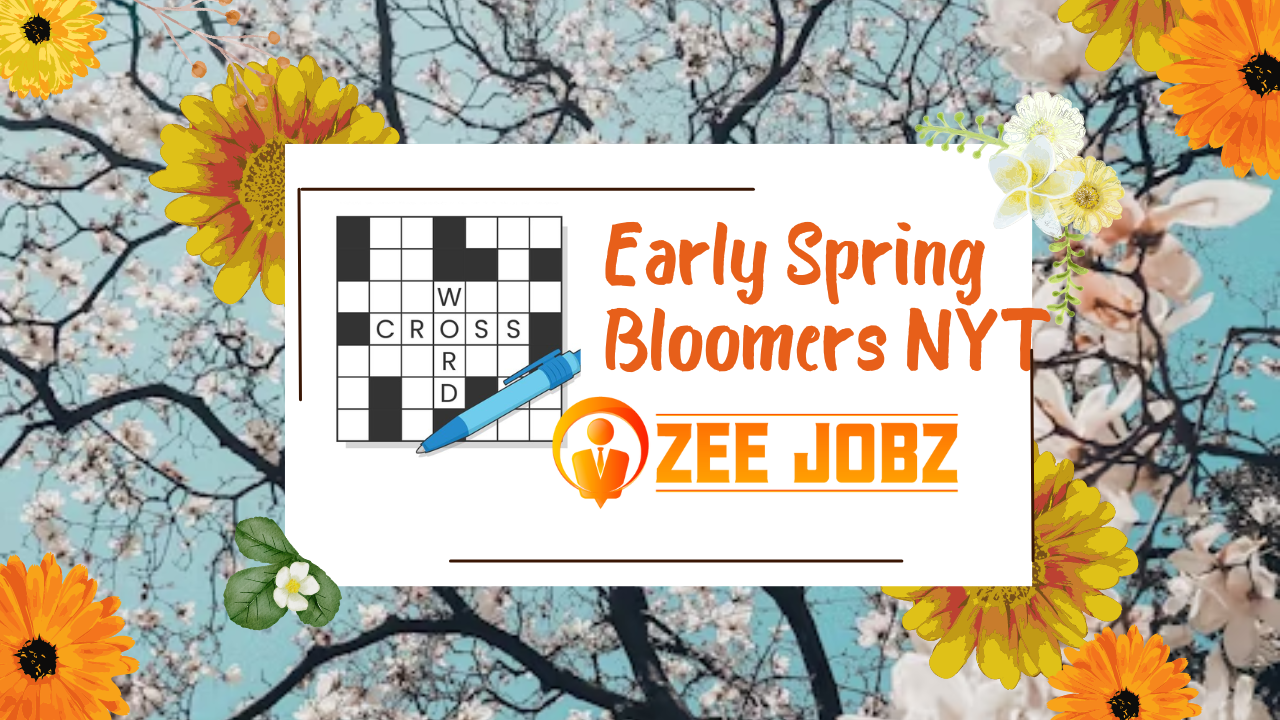In the vast landscape of crossword puzzles, the clue “Early Spring Bloomers NYT cauliflowers” from The New York Times crossword puzzle often stands out as a satisfying feat for the puzzler. This guide is a charming intersection of gardening and puzzle-making, bringing together plant enthusiasts and crossword lovers. In this newsletter, we’ll delve into the importance of this clue, explore its unusual solutions, and highlight its place in every botanical and crossword puzzle creation.
Clue Comprehension: Early Spring Bloomers NYT
The clue “Early Spring Bloomers NYT” usually refers to flowers that may bloom first as the ice gives way to spring. These plants are celebrated for bringing color and life to gardens, while many remain dormant. In the context of crosswords, this hint requires solvers to remember the unique flora that heals the description, often trying to understand each familiar and lesser-known species.
Typical answers to the clue

Snowdrops
Description: Snowdrops are iconic Early Spring Bloomers NYT that regularly emerge from the snow. Delicate white flowers in the shape of tears characterize them.
Crossword Context: Snowdrops regularly appear in crossword puzzles due to their exceptional appearance and early blooming nature. They are often indicated straightforwardly, making them a standard answer.
Crocuses
Description: Crocuses are colorful flora in various hues, including red, yellow, and white. They are among the first to bloom and are known for their joyful look.
Crossword Context: Crocuses are another popular answer due to their vibrant and recognizable vegetation. They often lend themselves well to crossword puzzles because of their exceptional names and diverse color variations.
Primroses
Description: Primrose is famous for its rich colors and early flowering. They are available in sunny shades such as pink, rose, yellow, and white.
Crossword Context: The call “primrose” regularly fits neatly into the crossword grid, making it a popular choice for clues associated with blooming Early Spring Bloomers NYT.
Hellebore
Description: Hellebores, or “Lenten roses,” are hardy perennials that bloom in late winter to early spring. Their flora can be white, crimson, or dark burgundy.
Crossword Context: Although less common than snowdrops or crocuses, geraniums may also appear in more complex puzzles due to their less common meaning in typical verbal exchanges.
Eranthis hyemalis
Description: Winter oleanders are cheerful bowl-shaped plants that bring a flash of yellow to pre-spring gardens.
Crossword Context: The distinct call and appearance make this plant a good solution for extra tricky clues.
The role of pre-spring flowering in botany
Early Spring Bloomers NYT are big in botany for many reasons:
- Pollinator Support: These flowers offer critical assets to early-season pollinators such as bees and butterflies. Many beetles emerge from winter hibernation and rely on this early vegetation for nectar and pollen.
- Seasonal transition: Early blooms help with the transition from winter weather to spring and provide a glimpse of the new season’s capabilities. Their presence is a sign of a changing climate and the return of warmer temperatures.
- Ecological balance: By blooming early, these flowers contribute to the environmental balance of gardens and herb landscapes. They help stabilize the soil, support the local natural world, and beautify biodiversity.
Making crossword puzzles with pre-springs
Including Early Spring Bloomers NYT in crosswords is a testament to the elaborate dating between botanical information and puzzle design. Designers often use these plants as guides for several reasons:
- Variety and Challenge: Early Spring Bloomers NYT provides a variety of answers, from standard to difficult to understand. This variety gives the puzzles an intensity and challenge, making them extremely attractive to solvers.
- Theme Integration: In themed puzzles, Early Spring Bloomers NYT florists can contribute to a seasonal or nature-based theme to add to the fun.
- Educational value: Including botanical terms in crossword puzzles can educate solvers about unique plant life, improve their understanding of horticulture, and encourage further exploration of natural internationals.

The intersection of crossword puzzles and gardening
Crossword puzzles are a source of entertainment and a means of gaining knowledge and discovery. The “Early Spring Bloomers NYT bloomer” clue exemplifies how puzzles can bridge the gap between entertainment and education. By providing botanical clues, crossword builders introduce solvers to the beauty and variety of flowers, promoting a greater appreciation for the world of herbs.
The intersection of crossword puzzles and gardening
Including Early Spring Bloomers NYT in crossword puzzles is not the most compelling evidence of several clues. Still, it highlights the broader connection between crossword fanatics and gardening enthusiasts. This intersection enriches both interests and provides a deeper appreciation for plant life’s role in our lives.
The cultural impact of pre-spring bloomers
Early Spring Bloomers NYT have a rich cultural significance beyond their botanical features. They often represent renewal, hope, and the transition from winter weather to spring. This cultural symbolism makes them compelling subjects in both gardening and crossword puzzles.
- Symbolism of renewal: These flowers are often harbingers of renewal and new beginnings. Their potential to bloom amid lingering winter weather reflects resilience and the promise of warmer days. In a cultural context, they are often associated with themes of rebirth and rejuvenation.
- Seasonal Traditions: Many cultures celebrate the arrival of spring with festive events and traditions that honor the season’s first flowers. For example, the Japanese subculture of “hanami” celebrates the blooming of cherry blossoms, even though it occurs later in the spring. Similarly, Early Spring Bloomers NYT regularly appear at neighborhood parties and gardening activities.
- Art and Literature: Images of Early Spring Bloomers NYT often appear in art and literature. Poets and artists use these flowers to evoke spring’s beauty and capture the essence of the changing seasons. Their presence in crosswords can be seen as an extension of this inventive appreciation.
Crossword Strategy and Early Spring Bloomers NYT
Crossword lovers may encounter the “Early Spring Bloomers NYT” clue of varying difficulty, relying on the solver’s familiarity with botanical terms. Here are some strategies to address these clues:
- Cross References: Use the letters from the intersecting answers to help identify the key to Early Spring Bloomers NYT. Partial answers or letters from neighboring clues often offer critical pointers.
- Botanical knowledge: Learn about unusual Early Spring Bloomers NYT and their characteristics. Knowing the names and signs of vegetation, such as snowdrops, crocuses, and primroses, can be a helpful resource in solving related crossword puzzles.
- Pattern Recognition: Look for unusual letter patterns and word lengths that match the clue. Many Early Spring Bloomers NYT have unique names that match recognizable patterns, which could help narrow down possible answers.
- Using Resources: Crossword solvers can use botanical reference materials, online resources, or crossword puzzle apps to help with challenging clues. These resources can provide additional context and help validate solutions.
The broader challenge of botanical clues
Botanical clues, such as those associated with flowers in early spring, appeal to a broad audience. They bring lovers together in various activities, from gardening to word games, and promote a shared appreciation of nature.
- Educational value: Botanical guides provide learning opportunities by introducing solvers to exceptional plant species. This information can encourage gardeners to discover new vegetation and decorate their gardens.
- Community Engagement: Puzzles featuring botanical themes regularly interact with communities of solvers and gardeners. These shared hobbies can give rise to discussions, forums, and events resembling crossword puzzles and gardening.
- Cultural Enrichment: Crossword puzzles, by including botanical clues, contribute to cultural enrichment. They offer a platform to explore the relationship between humans and nature, highlighting the beauty and importance of vegetation in our lives.
The future of botanical clues in crossword puzzles
As the crossword puzzle arena adapts, perhaps including botanical clues will remain a staple. The appeal of Early Spring Bloomers NYT and other plant clues is enduring, reflecting our continued fascination with nature and our preference to connect with seasons of transformation.
- Innovative Clues: Future puzzles may also feature revolutionary and creative clues related to botanical themes. As designers test new formats and themes, we may see even more attractive plant-related clues.
- Expanding knowledge: Including a much wider variety of plant species in crossword puzzles can broaden solvers’ knowledge and the recognition of the international herbal community. This trend should lead to greater recognition of lesser-known flowers and their roles in ecosystems.
- Enhanced Engagement: The intersection of crosswords and botany offers opportunities for greater engagement. Interactive puzzles, academic content, and botanical-themed networking activities can deepen our connection with every gardening and word game.
Accepting the harmony of nature and puzzles
The incorporation of Early Spring Bloomers NYT into crosswords exemplifies a beautiful harmony between nature and adventure. As solvers encounter these botanical clues, they can be drawn into an international setting where changing seasons and plants intersect with the artwork of puzzle-making. This combination is now not only the most adept and profitable mental exercise, but it also offers the opportunity to connect more deeply with the natural world.
The guides celebrate the colorful and ephemeral beauty of Early Spring Bloomers NYT, recalling the cyclical rhythms of nature and the joy this vegetation brings as it ushers in the arrival of warmer days. Enticing with such clues, puzzlers can develop a more prosperous expertise in both gardening and the intricate art of crossword puzzles and appreciate how these seemingly separate geographies come together to create a fulfilling and rewarding revelry.

The educational and inspirational impact of botanical crosswords
Incorporating botanical themes, including Early Spring Bloomers NYT, into crosswords provides educational and inspirational benefits for everyone. These traces offer researchers valuable insights into plant species that might otherwise remain unusual. By decoding these clues, individuals will not only expand their vocabulary but also expand their understanding of gardening. This instructional aspect of crosswords promotes a deeper understanding of the range and significance of the flora in our surroundings.
Additionally, the solution system of these botanical guides can inspire gardeners and nature lovers to discover new flora and gardening strategies, ultimately enriching their private gardens and landscapes. The interplay between solving puzzles and gaining knowledge about nature highlights that crosswords can be a powerful tool for eyebrow-raising and environmental attention, combining the pleasures of wordplay with the wonders of the herbal world.
End
Finally, the “Early Spring Bloomers NYT bloomer” clue is a captivating blend of horticultural know-how and crossword craft. Whether you’re a seasoned solver or a gardening fanatic, learning about the significance of this key will enrich your appreciation of each field. When you come up with this clue for your next puzzle, you’ll have a deeper insight into the Early Spring Bloomers NYT vegetation that brings joy and shade to our gardens and the complex art of crossword puzzles.



